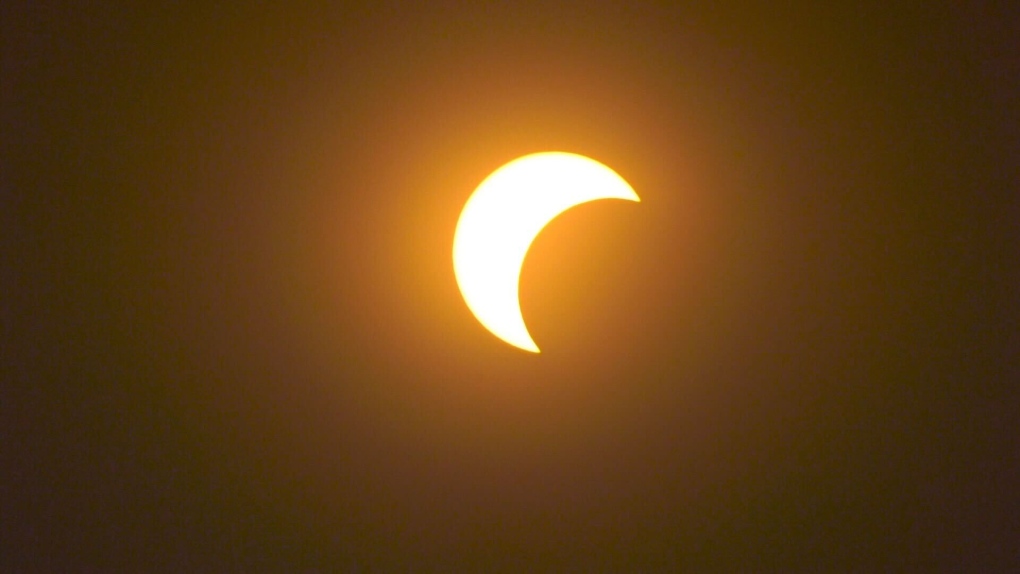'It's a beautiful sight': Edmontonians gather to watch solar eclipse Saturday
Hundreds of sky watchers headed to Coronation Park Saturday morning.
Through special glasses and telescopes, visitors at the Telus World of Science Edmonton (TWOSE) watched an annular solar eclipse – sometimes called a ring of fire.
"During this type of an eclipse in certain places, the moon's disk is slightly smaller than the sun's disk," said Frank Florian, senior manager of the TWOSE Planetarium and Space Sciences.
"That's where you get that ring of fire or that kind of bright region around the silhouette of the moon," he added. "Unfortunately, we don't get to see that."
The eclipse was visible across the Americas, but Florian said only those in parts of the United States would be able to see the ring of fire.
"I'd love to see more of the eclipse, but you really can't argue with Mother Nature," said TWOSE visitor Daphne Chen.
In Edmonton, people lined up between 9 a.m. and noon to watch the event through the telescope at the RASC Observatory near the science centre.
"I love the excitement of kids when they go up to the eyepiece and they go, 'Wow.'" Florian said.
"We're here to engage the public, get them excited about things like this.
"Because nature is wonderful, and watching nature unfold with a solar eclipse like this – it's a beautiful sight." The annular solar eclipse seen from Edmonton on Saturday, Oct. 14. (Amanda Anderson/CTV News Edmonton)
The annular solar eclipse seen from Edmonton on Saturday, Oct. 14. (Amanda Anderson/CTV News Edmonton)
Other visitors enjoyed the eclipse using special glasses or with telescopes brought and shared by amateur astronomers.
"Lots of the telescopes people brought out are pretty neat to see. And there's even a homemade one, which is pretty impressive," said Yannick Letailleur.
"It was so cool," said Claira Tanner. "I remember a few years ago we saw one of these through the glasses, but seeing through the telescope takes it up that extra notch."
Florian said there is lots to look forward to for local astronomy buffs beyond Saturday's solar eclipse.
"Right now the sun is starting to become more and more active with more and more of these active regions around sunspots," he said. "That means the sun is going to be spewing forth a lot of material … and that's when we get those spectacular Northern Lights."
There are also a few meteor showers expected to arrive over the next few months.
"If you're out and about on a nice clear night, you might notice a streak of light or even a bright kind of streak light passing across the sky," Florian said.
The Orionid meteor shower peaks Oct. 21 and 22 and the larger, more active Geminid shower will appear the night of Dec. 14.
In April, there will be a total solar eclipse. However, it will be the most visible from eastern Canada.
"That’s going to be a big event," Florian said. "We haven’t had that many total solar eclipses from Canada within our lifetime. There was one I remember in 1979, but you had to be in Manitoba to see that one."
The next full solar eclipse visible from Edmonton, and most of Alberta, takes place Aug. 22, 2044.
"So we have a few years to wait before we get to see one of these really spectacular events where the moon blocks the entire sun and we see basically a black hole in space," Florian said.
With files from CTV News Edmonton's Amanda Anderson
CTVNews.ca Top Stories

Donald Trump says Canada becoming 51st U.S. state 'a great idea'
U.S. President-elect Donald Trump is taking aim at Canada once more, saying it would be 'a great idea' to make it America's ‘51st state.'
'You're either with Beijing or you're with Washington': Ford says to Mexico in CNN interview
Ontario Premier Doug Ford has a message for Mexico as the threat of tariffs by incoming president Donald Trump hangs over both sides of the U.S. border.
There are 88 new Order of Canada appointees. Here's a look at some of the most notable names
Ryan Reynolds, Scott Oake and Maureen Ann Jennings are among the 88 new recipients of the Order of Canada.
NEW These seniors were hit by the affordability crisis in a different way. They're having to support their children and grandchildren
With the high cost of living increasingly a concern, some seniors are making sacrifices to help their adult children and grandchildren make ends meet. Here are some of their stories.
Thousands of toddler step stools recalled after child's head gets stuck
Thousands of toddler step stools are being recalled after a child's head got stuck in one.
Iconic Halifax ship Theodore Too partially sunk at Ontario dock
An iconic ship that was a fixture in Halifax Harbour for 21 years has partially sunk in Ontario.
Brazilian judge orders Adele song removed over plagiarism claim
A judge in Rio de Janeiro has ordered the global removal of a 2015 song by British singer Adele due to a plagiarism claim by a Brazilian musician, which Universal Music is fighting on appeal.
After scamming their victims, some con artists go on to scam our courts with impunity
Convicts, including fraudsters, are skipping out on their court-ordered payments to their victims to the tune of tens of millions of dollars across the country, according to figures obtained by CTV W5.
Synagogue on Montreal's West Island targeted by alleged arson
A synagogue on Montreal's West Island was the target of an alleged arson attack.

































